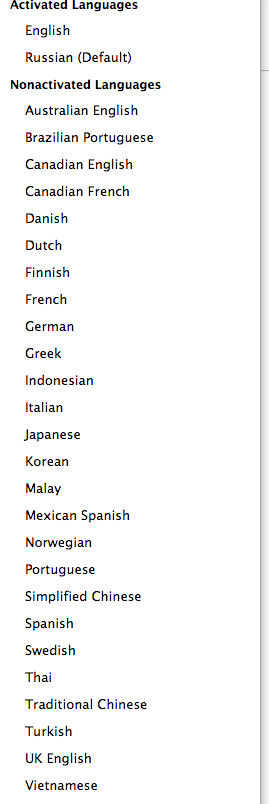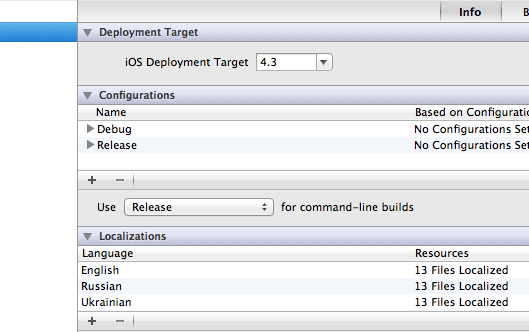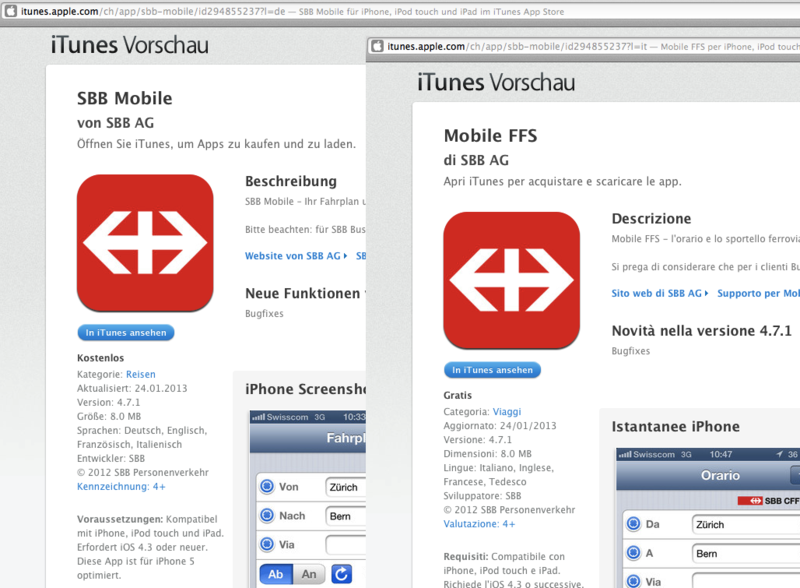Cognitive Anatomy of Languages in iTunes
Hi Habr,
Those who faced with the localization of ios applications in different languages, could not help but pay attention to all the magnificent variety of language settings in the Itunes Store and in Itunes Connect. There are so many of them that at once you will not understand where, what, and in what language it will be displayed. With this post, I will try to conduct those who are interested in the inexperienced through language measurements of the not always understandable and convenient Itunes economy and, therefore, save from feelings (from mild astonishment a la "Vono is like ..." to a severe stupor like "what the hell? , well, and perhaps from errors. And experienced, I think, will find for themselves some new moments.
If there is still nothing in the mobile language store, then when it comes to web browsing, the iTunes and iTunes preview are sometimes language surprises. We have 5 measurements:
')

A bit of a cap: You can configure them for each language in Itunes Connect when you submit applications to the appstore. And they have nothing to do with the languages into which you translated the application interface. Moreover, you should not rush to take screenshots from the Bengali or Farsi version of your application (in principle, I bent from Farsi ... just even Ukrainian), because the list of languages into which these three parameters can be localized is very limited, although they cover most of Earthlings:

They are much smaller than the countries for which a separate app was created. Therefore, for “deprived” countries, the name, description and screenshots that you added for the language marked Default will be displayed. Those. If you have a default language - Russian, then when entering the Japanese appstore - it will be in Russian. But there is always a “but”:
A couple of useful points:
It will show just the languages into which you translated the application directly and added localization in Xcode:

If you did not add localizations, then, in general, you do not need to read this post. But just in case and in order not to get into an unexpected situation like the guys here , it is useful to know that in such a case the language from the CFBundleDevelopmentRegion parameter will be shown. For example, I have English
This is not a language, but an identifier of the country of the appstore, but in fairness, I must say that changing it will change the interface language of the page to “native” for this country, change user reviews, and also change the “name-description-screenshots” trio to English if it is added to you and is “native” for this country, or otherwise - to default.
Certainly nice to throw the user on a page with five-star reviews and in a language he understands. But the language of reviews does not change, they are tightly tied to the country and can be in any desired language. In principle, this does not create problems if the same language is spoken in the country.
If you, for example in the American side of us, have bad reviews, it will be wise to give users a link with the identifier of some other English-language site, where the reviews are better. For example, Canadian - "sa" or British "uk". One way or another, the user will click on the “View in Itunes” button on the desired page.
It is useful to indicate it when the country of storage has several languages, such as: Canada (en, fr), Switzerland (de, it, fr) and so on. At the same time, it is necessary that Stor “understand” this parameter. l = ru does not work for the Swiss side - it will seem in its “native” - German. For all the appstores, without exception, only l = en will work.
This parameter changes the language of everything on the page, except for some interface ones, including the Watch in iTunes button (well, except for reviews).
Here is an example of the railway in German and Italian

I hope these small tips and Apple's iTunes Link Maker will help you direct users to the pages you need and increase your conversion.
Those who faced with the localization of ios applications in different languages, could not help but pay attention to all the magnificent variety of language settings in the Itunes Store and in Itunes Connect. There are so many of them that at once you will not understand where, what, and in what language it will be displayed. With this post, I will try to conduct those who are interested in the inexperienced through language measurements of the not always understandable and convenient Itunes economy and, therefore, save from feelings (from mild astonishment a la "Vono is like ..." to a severe stupor like "what the hell? , well, and perhaps from errors. And experienced, I think, will find for themselves some new moments.
If there is still nothing in the mobile language store, then when it comes to web browsing, the iTunes and iTunes preview are sometimes language surprises. We have 5 measurements:
')

# 1 on the first picture is: Name, description and screenshots
A bit of a cap: You can configure them for each language in Itunes Connect when you submit applications to the appstore. And they have nothing to do with the languages into which you translated the application interface. Moreover, you should not rush to take screenshots from the Bengali or Farsi version of your application (in principle, I bent from Farsi ... just even Ukrainian), because the list of languages into which these three parameters can be localized is very limited, although they cover most of Earthlings:

They are much smaller than the countries for which a separate app was created. Therefore, for “deprived” countries, the name, description and screenshots that you added for the language marked Default will be displayed. Those. If you have a default language - Russian, then when entering the Japanese appstore - it will be in Russian. But there is always a “but”:
- If you have added content under the English language, then itunes is smart enough to ignore your default language and show exactly English for those countries for which (according to Itunes) it is native, such as: UK, Canada , Australia ... and Ukraine, by the way, too. Yes, Apple wrote to me, puzzling about this, that "... works as expected". So, if you want to show in Ukraine in the default language - you will have to demolish the English language
- The language can be controlled using the “l” parameter in the link, but with restrictions. About this slightly lower in paragraph 5
A couple of useful points:
- While in order to add a new language you need to add a new version of the application (or make a reject current), the content for already added languages can be changed anytime and anywhere.
- In principle, for any language, you can shove text and screenshots in any language. Apple is comfortable with that. Or combine several languages in one description, changing their order. Especially if we are talking about languages that are not listed in iTunes Connect and you have a short description.
# 2 on the first picture is: Languages from the bundle
It will show just the languages into which you translated the application directly and added localization in Xcode:

If you did not add localizations, then, in general, you do not need to read this post. But just in case and in order not to get into an unexpected situation like the guys here , it is useful to know that in such a case the language from the CFBundleDevelopmentRegion parameter will be shown. For example, I have English
# 3 on the first picture is: Appstor of which country (not language)
This is not a language, but an identifier of the country of the appstore, but in fairness, I must say that changing it will change the interface language of the page to “native” for this country, change user reviews, and also change the “name-description-screenshots” trio to English if it is added to you and is “native” for this country, or otherwise - to default.
# 4 on the first picture is: Language reviews
Certainly nice to throw the user on a page with five-star reviews and in a language he understands. But the language of reviews does not change, they are tightly tied to the country and can be in any desired language. In principle, this does not create problems if the same language is spoken in the country.
If you, for example in the American side of us, have bad reviews, it will be wise to give users a link with the identifier of some other English-language site, where the reviews are better. For example, Canadian - "sa" or British "uk". One way or another, the user will click on the “View in Itunes” button on the desired page.
# 5 on the first picture is: The mysterious parameter "l = en" and the interface language. With bugs
It is useful to indicate it when the country of storage has several languages, such as: Canada (en, fr), Switzerland (de, it, fr) and so on. At the same time, it is necessary that Stor “understand” this parameter. l = ru does not work for the Swiss side - it will seem in its “native” - German. For all the appstores, without exception, only l = en will work.
This parameter changes the language of everything on the page, except for some interface ones, including the Watch in iTunes button (well, except for reviews).
Here is an example of the railway in German and Italian

I hope these small tips and Apple's iTunes Link Maker will help you direct users to the pages you need and increase your conversion.
Source: https://habr.com/ru/post/174433/
All Articles